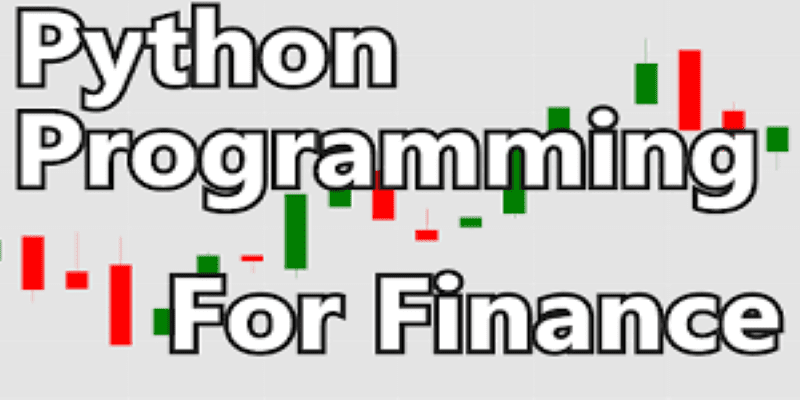
About Course
Python Programming for Finance in 2020
Are you ready to learn python programming fundamentals and directly apply them to solve real-world applications in Finance and Banking?
If the answer is yes, then welcome to the “The Complete Python and Machine Learning for Financial Analysis” course in which you will learn everything you need to develop practical real-world finance/banking applications in Python!
This course is unique in many ways:
1. The course is divided into 4 main parts covering python programming fundamentals, financial analysis in Python, and AI/ML application in Finance/Banking Industry, also Python for Financial Analysis and Algorithmic Trading. A detailed overview is shown below:
a) Part #1 – Python Programming Fundamentals: Beginner’s Python programming fundamentals covering concepts such as data types, variables assignments, loops, conditional statements, functions, and file operations. In addition, this section will cover key Python libraries for data science such as Numpy and Pandas. Furthermore, this section covers data visualization tools such as Matplotlib, Seaborn, Plotly, and Bokeh.
b) Part #2 – Financial Analysis in Python: This part covers Python for financial analysis. We will cover key financial concepts such as calculating daily portfolio returns, risk, and Sharpe ratio. In addition, we will cover the Capital Asset Pricing Model (CAPM), Markowitz portfolio optimization, and efficient frontier. We will also cover trading strategies such as momentum-based and moving average trading.
c) Part #3 – AI/Ml in Finance/Banking: This section covers practical projects on AI/ML applications in Finance. We will cover the application of Deep Neural Networks such as Long Short Term Memory (LSTM) networks to perform stock price predictions. In addition, we will cover unsupervised machine learning strategies such as K-Means Clustering and Principal Components Analysis to perform Baking Customer Segmentation or Clustering. Furthermore, we will cover the basics of Natural Language Processing (NLP) and apply it to perform stock sentiment analysis.
D) Part #4 – Python for Financial Analysis and Algorithmic Trading
2. There are several mini-challenges and exercises throughout the course and you will learn by doing. The course contains mini-challenges and coding exercises in almost every video so you will learn in a practical and easy way.
3. The Project-based learning approach: you will build more than 6 full practical projects that you can add to your portfolio of projects to showcase your future employer during job interviews.
So why Python?
Python is ranked as the number one programming language to learn in 2020, here are 6 reasons you need to learn Python right now!
1. #1 language for AI & Machine Learning: Python is the #1 programming language for machine learning and artificial intelligence.
2. Easy to learn: Python is one of the easiest programming languages to learn especially if you have not done any coding in the past.
3. Jobs: high demand and low supply of python developers make it the ideal programming language to learn now.
4. High salary: Average salary of Python programmers in the US is around $116 thousand dollars a year.
5. Scalability: Python is extremely powerful and scalable and therefore real-world apps such as Google, Instagram, YouTube, and Spotify are all built on Python.
6. Versatility: Python is the most versatile programming language in the world, you can use it for data science, financial analysis, machine learning, computer vision, data analysis and visualization, web development, gaming, and robotics applications.
Who this course is for:
-
- Aspiring data scientists
- Programming beginners
- People interested in finance and investments
- Programmers who want to specialize in finance
- Everyone who wants to learn how to code and apply their skills in practice
- Finance graduates and professionals who need to better apply their knowledge in Python
Course Content
Python Programming for Finance
-
Intro and Getting Stock Price Data
09:34 -
Research – Algorithmic Trading with Python and Quantopian p. 4
00:00 -
Pipeline – Algorithmic Trading with Python and Quantopian p. 5
00:00 -
Analyzing Alpha Factors with Alphalens – Algorithmic Trading with Python and Quantopian p. 6
00:00 -
Backtesting Alpha Factor – Algorithmic Trading with Python and Quantopian p. 7
00:00 -
Analyzing Backtest with Pyfolio – Algorithmic Trading with Python and Quantopian p. 8
00:00 -
Strategizing – Algorithmic Trading with Python and Quantopian p. 9
00:00 -
Finding more Alpha Factors – Algorithmic Trading with Python and Quantopian p. 10
00:00 -
Combining Alphas – Algorithmic Trading with Python and Quantopian p. 11
00:00 -
Portfolio Optimization API – Algorithmic Trading with Python and Quantopian p. 12
00:00 -
Installation – Zipline Tutorial local backtesting and finance with Python p.1
00:00 -
Visualizing Strategy Metrics – Zipline Tutorial local backtesting and finance with Python p.2
09:09 -
Custom Data Panel – Zipline Tutorial local backtesting and finance with Python p.3
00:00 -
Schedule Function – Algorithmic Trading with Python and Quantopian p. 3
00:00 -
Orders and Leverage – Algorithmic Trading with Python and Quantopian p. 2
00:00 -
Handling Data and Graphing
08:51 -
Basic Stock data Manipulation
00:00 -
More stock manipulations
00:00 -
Automating getting the S&P 500 list
00:00 -
Getting all company pricing data in the S&P 500 –
00:00 -
Combining S&P 500 into one DataFrame
00:00 -
S&P 500 company correlation table
00:00 -
Preprocessing data for Machine Learning
00:00 -
Creating machine learning target function
00:00 -
Creating labels for Machine Learning
00:00 -
Machine learning
00:00 -
Algorithmic Trading with Python and Quantopian p. 1
00:00 -
Trading Custom Markets (bitcoin example) – Zipline Tutorial finance with Python p.4
00:00
Student Ratings & Reviews

